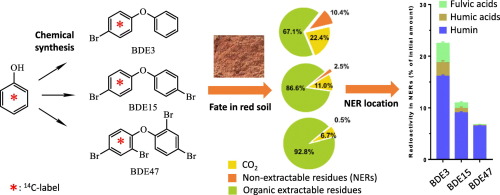当前位置:
X-MOL 学术
›
Sci. Total Environ.
›
论文详情
Our official English website, www.x-mol.net, welcomes your feedback! (Note: you will need to create a separate account there.)
Fate of lower-brominated diphenyl ethers (LBDEs) in a red soil - Application of 14C-labelling.
Science of the Total Environment ( IF 8.2 ) Pub Date : 2020-03-03 , DOI: 10.1016/j.scitotenv.2020.137735 Yao Yao 1 , Yue Zhou 1 , Wenji Wang 1 , Dashun Zhou 2 , Lianhong Wang 1 , Philippe F-X Corvini 3 , Rong Ji 4
Science of the Total Environment ( IF 8.2 ) Pub Date : 2020-03-03 , DOI: 10.1016/j.scitotenv.2020.137735 Yao Yao 1 , Yue Zhou 1 , Wenji Wang 1 , Dashun Zhou 2 , Lianhong Wang 1 , Philippe F-X Corvini 3 , Rong Ji 4
Affiliation

|
Lower-brominated diphenyl ethers (LBDEs) occur ubiquitously in soil, however their fate there has not been well evaluated, mainly owing to that the unavailability of commercial radioactively labelled LBDE congeners hampers the investigation on fate of LBDEs in the environment with complex matrixes, such as soil and sediment. Here, we successfully synthesized three congeners of LBDEs, i.e., 4-bromodiphenyl ether (BDE3), 4,4'-dibromodiphenyl ether (BDE15), and 2,2',4,4'-tetrabromodiphenyl ether (BDE47), with 14C-labelling on one aromatic ring, starting from commercially available 14C-labelled phenol in two steps with high yields and high radiochemical purities. Using the 14C-labelled congeners, we studied the fate of LBDEs in a red soil under oxic conditions, where LBDEs have been frequently detected in high levels. The major fate of the LBDE congeners in the soil was formation of NERs, followed by mineralization to CO2, while no transformation product was detected in the soil after incubation for 105 days. The mineralization strongly decreased with increasing number of the bromine atom on the congener molecule, amounting to 10.4 ± 0.3%, 2.45 ± 0.04%, and 0.51 ± 0.05% for BDE3, BDE15, and BDE47, respectively, at the end of incubation, while mineralization rate constant was independent of the molecular structure, suggesting that solubility of LBDEs is the limit factor for their persistence in soil. The mineralization was positively linearly correlated with the formation of NERs (22.5 ± 1.9%, 11.0 ± 3.6%, and 6.7 ± 2.7% for BDE3, BDE15, and BDE47, respectively), which was mainly located in humin fraction and formed also in sterilized soil, suggesting a binding of transformation intermediates to soil humic substances and a physico-chemical entrapment of LBDEs in soil. The results provide new insights into fate of LBDE congeners in soil, and suggest a need to elucidate nature of the NERs of LBDEs, especially the stability of NERs in the environment.
中文翻译:

红壤中低溴化二苯醚(LBDE)的命运-14C标记的应用。
低溴联苯醚(LBDEs)普遍存在于土壤中,但是其命运尚未得到很好的评估,这主要是由于缺乏商业放射性标记的LBDE同源物的存在阻碍了对复杂基质环境中LBDEs命运的研究。作为土壤和沉积物。在这里,我们成功地用14C合成了LBDE的三个同类物,即4-溴二苯醚(BDE3),4,4'-二溴二苯醚(BDE15)和2,2',4,4'-四溴二苯醚(BDE47)从市售14C标记的苯酚分两步以高收率和高放射化学纯度在一个芳香环上进行R-标记。使用14 C标记的同源物,我们研究了在有氧条件下红土中LBDEs的命运,在这些土壤中经常检测到高水平的LBDEs。LBDE同源物在土壤中的主要命运是NER的形成,随后矿化为CO2,而在温育105天后在土壤中未检测到转化产物。随着同系物分子上溴原子数目的增加,矿化作用大大降低,在孵育结束时,BDE3,BDE15和BDE47的矿化作用分别为10.4±0.3%,2.45±0.04%和0.51±0.05%。矿化速率常数与分子结构无关,表明LBDEs的溶解度是其在土壤中持久性的限制因素。矿化与NERs的形成呈线性正相关(BDE3,BDE15和BDE47分别为22.5±1.9%,11.0±3.6%和6.7±2.7%),其主要位于腐殖质级分中,并且也已灭菌泥,提示转化中间体与土壤腐殖质的结合以及土壤中LBDE的物理化学截留。该结果为了解土壤中LBDE同系物的命运提供了新见解,并表明有必要阐明LBDEs NER的性质,尤其是NER在环境中的稳定性。
更新日期:2020-03-03
中文翻译:

红壤中低溴化二苯醚(LBDE)的命运-14C标记的应用。
低溴联苯醚(LBDEs)普遍存在于土壤中,但是其命运尚未得到很好的评估,这主要是由于缺乏商业放射性标记的LBDE同源物的存在阻碍了对复杂基质环境中LBDEs命运的研究。作为土壤和沉积物。在这里,我们成功地用14C合成了LBDE的三个同类物,即4-溴二苯醚(BDE3),4,4'-二溴二苯醚(BDE15)和2,2',4,4'-四溴二苯醚(BDE47)从市售14C标记的苯酚分两步以高收率和高放射化学纯度在一个芳香环上进行R-标记。使用14 C标记的同源物,我们研究了在有氧条件下红土中LBDEs的命运,在这些土壤中经常检测到高水平的LBDEs。LBDE同源物在土壤中的主要命运是NER的形成,随后矿化为CO2,而在温育105天后在土壤中未检测到转化产物。随着同系物分子上溴原子数目的增加,矿化作用大大降低,在孵育结束时,BDE3,BDE15和BDE47的矿化作用分别为10.4±0.3%,2.45±0.04%和0.51±0.05%。矿化速率常数与分子结构无关,表明LBDEs的溶解度是其在土壤中持久性的限制因素。矿化与NERs的形成呈线性正相关(BDE3,BDE15和BDE47分别为22.5±1.9%,11.0±3.6%和6.7±2.7%),其主要位于腐殖质级分中,并且也已灭菌泥,提示转化中间体与土壤腐殖质的结合以及土壤中LBDE的物理化学截留。该结果为了解土壤中LBDE同系物的命运提供了新见解,并表明有必要阐明LBDEs NER的性质,尤其是NER在环境中的稳定性。








































 京公网安备 11010802027423号
京公网安备 11010802027423号